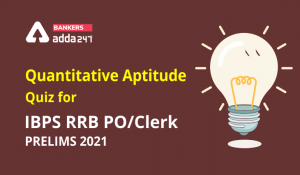Q1. How many even numbers of 5 digits can be formed using all the digits from 0 to 9 if repetition of digits is allowed?
Q2. An article is sold at a profit of 4/15th of its CP to a person. That person further sold it at 20% loss for Rs. 684. Find the difference of original cost price of that article and SP of article for that person.
Q3. A train passed a tunnel of length 105 m in 10 seconds running at a speed of 81 km/hr. Find the time taken by the train to cross a man running with a speed of 2.5 m/s in the same direction of train?
Q4. The smallest number of five consecutive even number series is 3 more than second largest number of five consecutive odd number series. Then find average of five consecutive odd number series is how much less than that of average of even number series?
Q5. When a sum is invested at 8% p.a at SI for 2 ½ years, the interest received is Rs. 490. When double of that sum is invested at 2% p.a. higher rate than earlier rate for 2 year at CI then amount received is ?
Directions (6-10): What will come in the place of question (?) mark in the following number series:
Q6. 15, 13, 23, 65, 255, ?
Q7. ?, 159, 183, 228, 302, 413
Q8. 3780, 7560, 5040, 2016, 576, ?
Q9. 711, ? , 1001, 1290, 1651, 2180
Q10. 1089, 1112, 1158, 1250, ? , 1802
Direction (11 -15)- There are three bags A, B & C and each contains balls of three different colors.
Bag A contains x blue and y red balls. Number of blue balls is 3 less than the number of red balls. If Abhi selected one ball, then the probability of getting yellow ball is 1/6. Value of x is 100/3% less than that of y.
Blue balls in bag B is 200% more than that of yellow balls in bag A. If Sandeep is selecting two balls at random then the probability of getting both red is 33/203. Total number of balls in bag B is 29.
In bag C, the number of red balls is 150% of blue balls and blue balls are 20% more than number of yellow balls in that bag. If Kamal is selecting two balls at random then the probability of getting blue ball is 11/130.
Q11. Total number of blue balls in bag A and B together is what percent more or less than total number of red balls in bag B and C together?
Q12. Number of total balls in bag D is 35% less than total number of balls in bag C and balls are of three same colors as above and out of which yellow balls are equal to average of blue balls in all the three given bags (A, B & C). If the probability of selecting a red ball from bag D is 6/13 then number of blue balls in bag D is what percent of total number of balls of bag A?
Q13. Find the ratio of difference between averages of yellow balls in all three bags taken together and 75/2% of total number of balls in bag C to the number of red balls in bag B?
Q14. Find the difference between total number of balls from bag A and B taken together and total number of balls from bag C?
Q15. ‘p’ number of black balls are added into bag A and (p+2) number of black balls are added into bag C. Find value of ‘p’ if probability of selecting a black ball from bag A is 1/12 more than probability of selecting a black ball from bag C. (Given: p<20)






 Quantitative Aptitude Quiz For IDBI AM/E...
Quantitative Aptitude Quiz For IDBI AM/E...
 Quantitative Aptitude Quiz For IBPS RRB ...
Quantitative Aptitude Quiz For IBPS RRB ...





